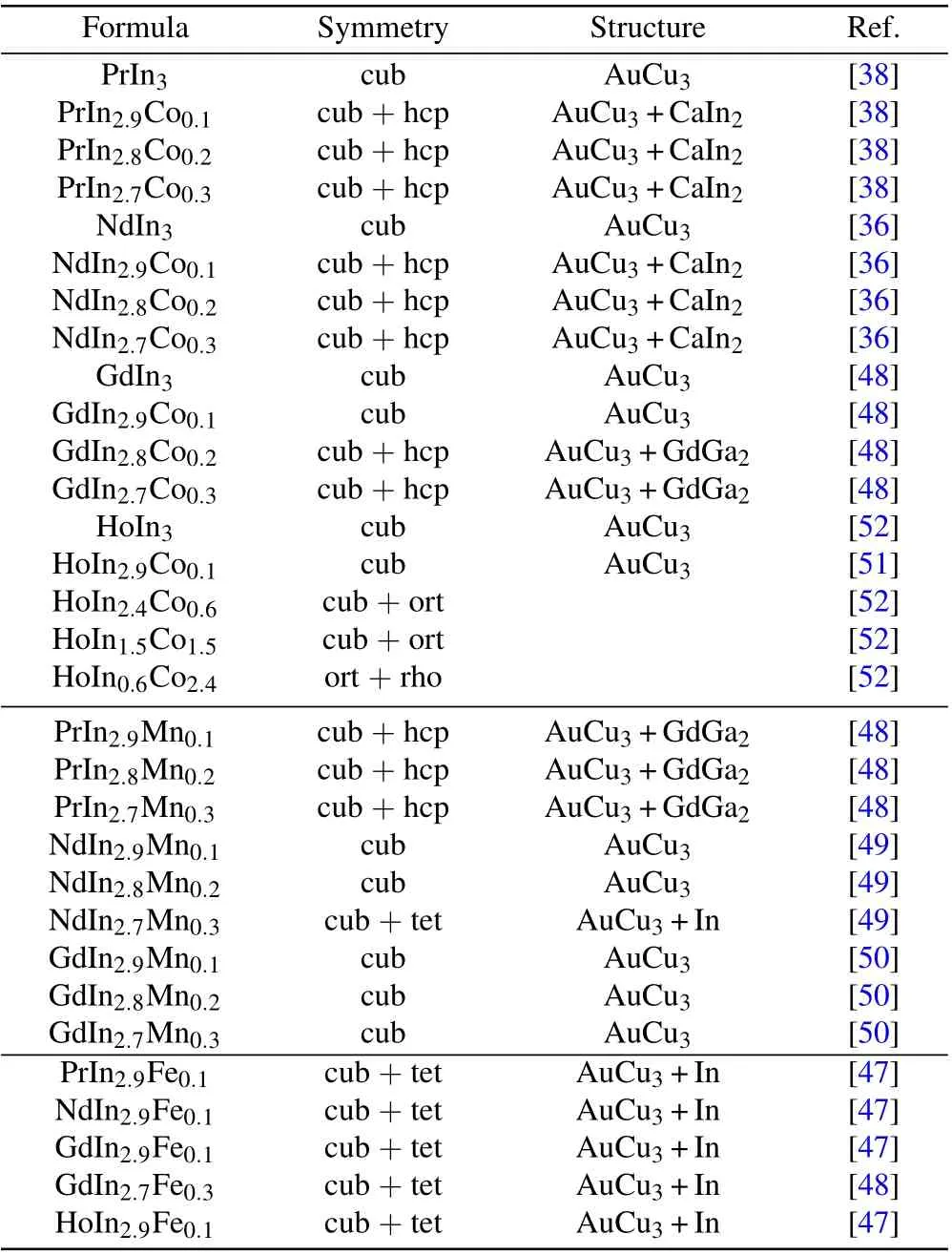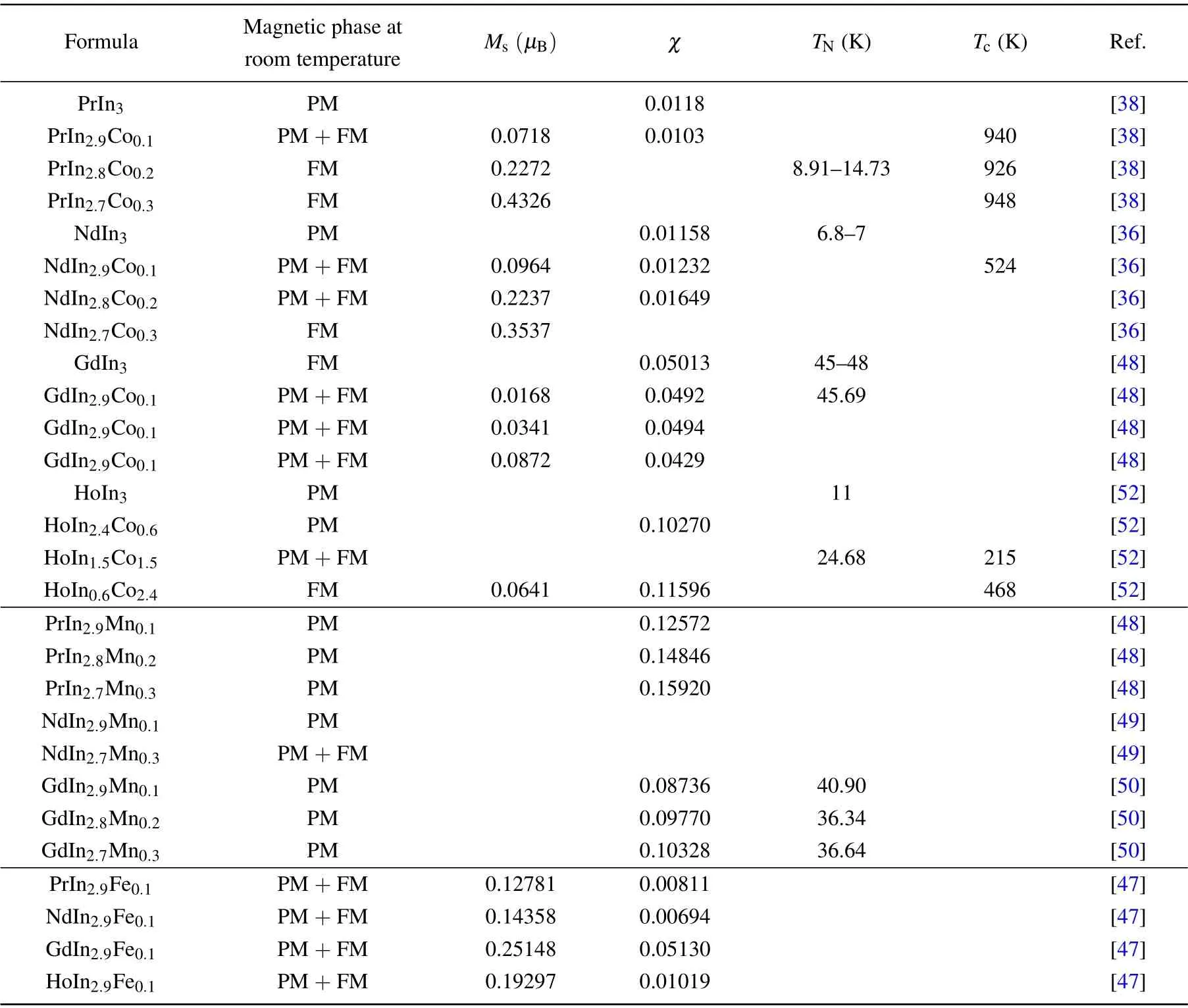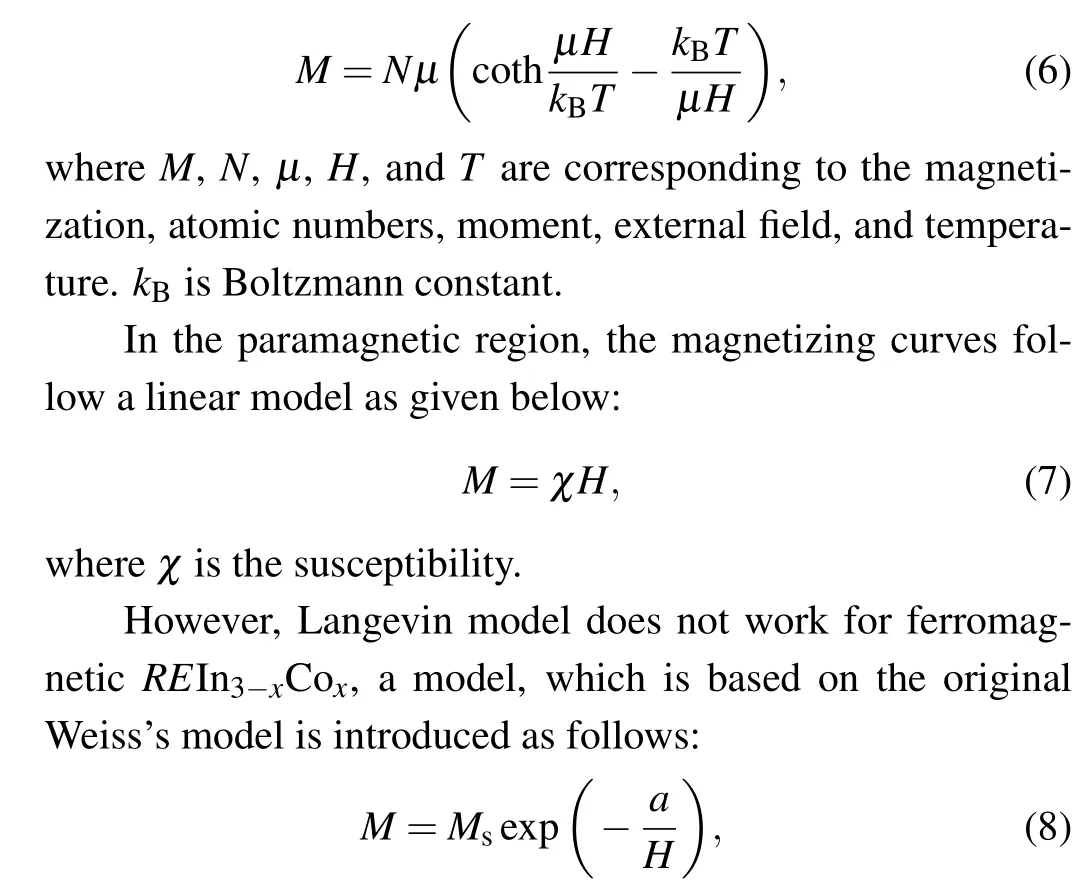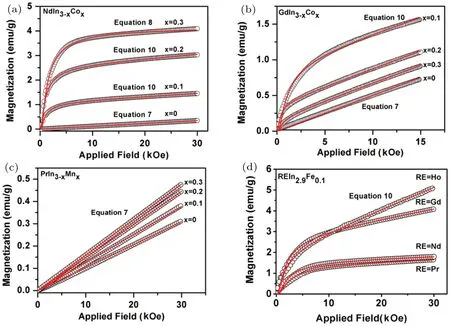A review on 3d transition metal dilute magnetic REIn3 intermetallic compounds
2022-03-12XinPengGuo郭新鹏YongQuanGuo郭永权LinHanYin殷林瀚andQiangHe何强
Xin-Peng Guo(郭新鹏), Yong-Quan Guo(郭永权), Lin-Han Yin(殷林瀚), and Qiang He(何强)
School of Energy Power and Mechanical Engineering,North China Electric Power University,Beijing 102206,China
Keywords: dilute magnetic intermetallic compounds, phase transition, magnetic properties, magnetic transport
1. Introduction
Over the last decades, the magnetic semiconductors have received much attention due to their potential application on spin-electronic devices by spin modulating electric transport.[1]According to the content of magnetic elements in semiconductor, two kinds of magnetic semiconductors are classified,which correspond to the concentrated magnetic semiconductor(CMS)and dilute magnetic semiconductor(DMS).The early study is mainly focused on EuX(X=O,Se) and CdCr2X4(X=S, Se) CMSs due to their unique ferromagnetic semiconductor characteristics.[2-5]Owing to the ferromagnetism in CMS, the band gap shows the red shift,which causes the exchange interaction between itinerant electrons and localized magnetic spins. However, the further development and application of CMS are restricted by their low Curie temperatures and complex preparation process.[6]Thus,the attention is changed to the magnetic atom/ion-doped IIIV,II-VI,IV-IV,and II-II-V group semiconductors.[7-15]The dilute magnetic semiconductor,which is formed by substituting minor magnetic ions for non-magnetic ions, has attracted much attention due to its excellent magnetic transport properties. In recent years, the novel chalcopyrite-based DMSs have been widely studied.[16]The room temperature ferromagnetism has been obtained in Cd1-xMnxGeP2,CuIn1-xCoxTe2,and Cr-doped CuZnSe2.[17-19]The ferromagnetism is suggested to originate from the spin-spin interactions of 3d transition metal.[19]The codoping of Co and Ce into CuInTe2induces the room temperature ferromagnetism. The magnetization of CuIn0.9CexCo0.1-xTe2is enhanced, which is ascribed to the exchanging interaction between 4f electron of Ce and 3d electron of Co. The high doping ratio of Co and Ce is beneficial for increasing saturation magnetization.[20]Mn-doped CuInSe2semiconductors show antiferromagnetic order with very low N´eel temperature.[21-23]CuIn1-xCoxSe2shows the superparamagnetism at room temperature.[24]
In recent years, the interest has been growing in the rare earth-indium (REIn3) compounds with a cubic AuCu3-type crystal structure.[25-27]REIn3shows remarkable features,such as heavy fermion,antiferromagnetism,superconductivity at critical temperature or pressure,crystal field effects,Kondo effect, and multiaxial magnetic structures.[25,27-34]CeIn3belongs to a heavy fermion and shows unique magnetic and electric properties such as antiferromagnetic order at 10 K,superconductivity under applied high pressure, and Kondo effect.[35]GdIn3orders antiferromagnetically at 45 K, which is the highest N´eel temperature among theREIn3intermetallic compounds.[36]The crystal electrical-field (CEF) ground state is a singlet for the PrIn3intermetallic compound,its lowtemperature susceptibility is almost temperature-independent,but inversely proportional to the splitting energy of the excited states. The two electrons in the unfilled 4f shell of the Pr ions form a multiplet withJ=4, giving rise to a magnetic moment ofμBgJwithg=0.8. A remarkable feature of PrIn3is a large nuclear quadrupole interaction (e2qQ/h=+228 MHz)at In site.[37,38]Ndln3is a typical 4f-localized intermetallic compound with a N´eel temperature below 5.9 K.With the increasing external magnetic field,the magnetic transformation from the antiferromagnetic to paramagnetic occurs.[39]HoIn3orders antiferromagnetically at 10.5 K and its magnetic structure is suggested to be multiaxial. The potential application of HoIn3as a regenerator material is also expected since its abnormal heat capacity is associated with the antiferromagnetic transition in the temperature range of 4 K-10 K.[40]
The dilute magnetic intermetallic compounds (DMIC)can be obtained by doping minor 3d transition metal(Co,Mn or Fe) into intermetallics.[41,42]Mn-doped EuMn0.3Ga2.7orders ferromagnetically at room temperature under applying a low field of 40 Oe (1 Oe=79.5775 A/m).[43]As for the dilute magneticREIn3, the studies mainly focus on the doping effects on the structure and magnetic properties at In site orREsite.[31,44,45]It is well known that the 3d transition metals play an important role in magnetic materials due to their significant contributions to the magnetization and magnetic anisotropy by coupling with 4f electrons of the rare-earth.[46]Since the pure Co is strongly ferromagnetic, it is expected to improve the magnetic property ofREIn3by doping minor Co. Doping of Co intoREIn3(RE=Pr, Nd,) induces a giant magnetic effect with Curie temperature more than room temperature.[36,38]The giant moment originates from the partial substitution of non-magnetic element In by magnetic element Co in the host material, and thus, a net moment is produced. The ferromagnetism is caused by the spin-spin interactions between Co and Co or Co andRE.
The objective of this paper is to introduce a brief review on minor doping of 3d transition metalTintoREIn3intermetallic compounds(RE=Pr,Nd,Gd,Ho;T=Co,Mn,and Fe). The transition of the structure and magnetic properties ofREIn3-xTxhave been systematically discussed.
2. Structural stability
As shown in Fig. 1,[36,38,47-51]all theREIn3alloys are single phase with a cubic AuCu3-type structure. The cubic structure is still stable by doping minor 3d transition metal intoREIn3. The single-phase region corresponds toREIn3xMnxwithx <0.3 andREIn3-xCoxwithx ≤0.1.However, the structural stability of cubic phase reduces with doping minor Fe intoREIn3.[47]The additional satellite peaks can be observed out of solid solution region ofREIn3-xCox. The satellite peaks can be indexed with a hexagonal CaIn2-type or GaGd2-type structure based on the structural refinement.[36,38,48,52]In element is detected out ofREIn3-xMnxsolid solution.[49]Doping minor Fe intoREIn3induces the decomposition of the cubic phase, and In is separated fromREIn3. With increasing Fe doping content, the metaphase is observed and its structural formula is suggested to beRE(In,Fe)2.[48]
The crystallographic parameters ofREIn3-xTxare summarized in Table 1.[36,38,47-53]According to the structural refinements, the main phase ofREIn3-xTxcrystallizes into a cubic AuCu3-type structure with a space group ofPm¯3m(as shown in Fig.2[52]).Two kinds of non-equivalent crystal positions are included in one unit cell.The atomic occupations correspond to the 1a(0,0,0)site forREatoms,and the 3c(1/2,1/2,0)site for In and transition metal Co,Mn or Fe atoms.

Fig.1. XRD patterns of REIn3-xTx intermetallic compounds: (a)REIn3;(b)REIn3-xCox;(c)REIn3-xMnx;(d)REIn2.9Fe0.1. The figures are adapted from Refs.[36,38,47-51].

Table 1. The crystal structure for REIn3-xTx alloys.

Fig.2. The structural frame of cubic REIn3-xTx. The figure is adapted from Ref.[52].
The structure of the metaphase is suggested as an isomorphic structure of CaIn2with a space group ofP63/mmc,Z=2 and GdGa2with a space group ofP6/mmm,Z=1. There are two non-equivalent crystal positions in a unit cell with CaIn2-type isomorphic structure,i.e.,2b(0,0,1/4)and 4f(1/3,2/3,z) crystal positions, which are occupied by 2REand 4(In,T)atoms,respectively. For GdGa2-type structure,the atomic occupations correspond to 1a(0,0,0)site forREatoms and 2d(1/3,2/3,1/2)site for In andTatoms,respectively. The lattice parameters of the main- and meta-phases are summarized in Tables 2 and 3.[47-50,52,53]

Table 2. The lattice parameters of the main phase in REIn3-xTx.

Table 3. The lattice parameters of the metaphase in REIn2-xTx.
Since the pure binaryREIn2does not exist naturally,REIn2-xTxalloy is prepared for checking its single-phase with CaIn2-or GaGd2-type structure. However,the phase identification confirms that the single phaseREIn2-xTxdoes not exist at all. It implies thatRE(In, Co)2is metaphase, which might originate from the crystal growing defect and separate from the cubic phase.The phase separation inREIn3-xCoxis suspected to be driven by the lattice distortion originated from the atomic size effect. The substitution of Co for In could cause a large lattice distortion and thus induces the structural reconstruction from cubicREIn3-xCoxto hexagonalREIn2-xCox. The projections of two structures reveal the mechanism of phase separation from the cubicREIn3to hexagonalREIn2-xCox. The reconstruction originates from the rotation of(In,Co)6 hexagonal ring, comparing to the projection of cubicREIn3along[111] direction, the structural skeleton ofRE(In, Co)2could be formed by rotating the (In, Co)6 hexagonal ring with an angle of 30°along[111]direction,as shown in Fig.3.[36]

Fig. 3. The projection of cubic phase along [111] direction in REIn3 and hexagonal phase along [001] direction in RE(In, Co)2. The figures are adapted from Ref.[36].
The atomic size can directly influence the crystal structures of materials. The phase transition and lattice distortion inREIn3-xTxmight be driven by the atomic size effect. Since the atomic radii of Co(1.25 °A),Mn(1.32 °A),and Fe(1.24 °A)are quite different from that of In(1.66 °A)or rare-earth atoms(more than 1.74 °A).The doping of Co,Mn or Fe induces large lattice distortion.
In order to discuss the effect of atomic size on the structural stability ofREIn3-xTxcubic phase, the effective atomic radius ratio is defined betweenREand (In, Co),REand (In,Mn),as well asREand(In,Fe).[47]
The effective atomic radius ratio equation ofREIn3is

RA,rR,〈rIn,M〉are the effective atomic radius ratio,the atomic radius ofRE, and the average atomic radius of In and transition metal(Co,Mn or Fe)respectively.
Table 4 shows the effective atomic radius ratio ofREIn3-xMxcompounds.[47-52]It implies that the cubic phase can be stabilized inRA<1.09 forREIn3-xCoxandRA<1.10 forREIn3-xMnx,respectively.
The electro-negativity difference between (In,M) and rare earth is also considered as a correlative criterion for the structural stability of the cubic phase. It is defined forREIn3

whereXIn,XRE, andXMare corresponding to the electronegativity of In, rare earth, and 3d transition metal, respectively.
The calculated electro-negativity differences show that the cubic phase ΔXranging from 0.384 to 0.397 forREIn3-xCoxand from 0.387 to 0.424 forREIn3-xMnx, as listed in Table 5.[47-52]

Table 4. The effective atomic radius ratios of REIn3-xTx alloys.

Table 5. The electro-negativity differences of REIn3-xTx alloys.
3. Magnetic properties
According to the temperature dependence of magnetization, Mn-doped NdIn3-xMnx(x <0.3) cubic phase shows the paramagnetic property at room temperature, however, a weak ferromagnetic property is observed out of its singlephase region.[49]The antiferromagnetic order is observed inREIn3-xTx(RE=Nd, Pr, Gd;T=Mn, Co)intermetallics in low-temperature region. Mn doping into GdIn3causes the decrease of N´eel temperature from 42.10 K to 31.66 K due to the distortion of Gd(In, Mn)3tetrahedron formed by Gd at corners and (In, Mn) at face centers in the unit cell. The formation of the antiferromagnetic ordering might originate from the exchanging interaction between the unpaired 4f electron spin ofREand the surrounding conduction electrons at low temperature.[50]REIn2.9Co0.1(RE=Pr,Nd)shows low temperature antiferromagnetic order and room temperature ferromagnetic order with Curie temperature more than 523 K.[36,38]

Table 6.Various magnetic properties for REIn3-xTx alloys.
According to the studies on magnetic properties ofREIn3-xTx,[36,38,47-50,52]the magnetic properties are summarized in Table 6. The magnetizing mechanisms ofREIn3-xTxare different for the various magnetic phase, Langevin model[54]is usually used in the ferromagnetic region:

whereMsis the saturation moment.
This equation could be rewritten by the Taylor series expansion algorithm as Weiss model

whereais a parameter related to the applied external field.
In the region of the mixed ferromagnetic and paramagnetic phase,the magnetization curve follows an equation as
where the first and second terms are the contributions to magnetization originating from the ferromagnetic and paramagnetic phases, respectively. The magnetization curves follow the three models in ferromagnetic, paramagnetic and mixture of ferromagnetic and paramagnetic regions, as shown in Fig.4.[36,47,48]

Fig.4. The magnetizing curves of REIn3-xTx at room temperature,solid lines and scatters correspond to fitting and observed results,respectively. (a)NdIn3-xCox,(b)GdIn3-xCox,(c)GdIn3-xMnx,(d)REIn2.9Fe0.1 (RE=Pr,Nd,Gd,and Ho). The figures are adapted from Refs.[36,47,48].
The magnetic properties ofREIn3-xCoxare sensitive to the Co doping content. With increasing Co content inREIn3-xCox, a mixture of ferromagnetic and paramagnetic phase is observed in NdIn3-xCox(x ≥0.2), PrIn3-xCox(x ≥0.2), respectively. The magnetic properties are strongly correlated to the phase structures. The magnetic transition from paramagnetic to ferromagnetic is caused by the phase separation of the hexagonal phaseREIn2-xCoxfrom cubic phase with increasing Co content. The saturation magnetic moment (Ms) also raises with the increase of Co contents inREIn3-xCox. The enhancement of magnetic moment ofREIn3-xCoxmight be due to the partial substitution of nonmagnetic element In by 3d transition metal Co in the host material and thus a net moment is produced. The evolution of magnetic phases inREIn3-xCoxmight result from the exchange interaction change from the one between the isolated Co spins with the surrounding conduction electrons in Copoor region to the one between Co-Co pairs mediated by the conduction electrons in Co-rich region.[36,38]The magnetizing behaviors ofREIn2.9Co0.1show complex magnetic properties at room temperature and follow a ferromagnetic model forRE= La and a mixed ferromagnetic and paramagnetic model forRE=Ce, Pr, Nd, Gd, Tb, Dy. The formation of ferromagnetic characteristic is suggested to result from the strong spin-spin interaction betweenREand Co. It implies that Co atoms play an important role in magnetic properties ofREIn2.9Co0.1.[55]The fitted and observedREIn3-xMnxexhibit paramagnetic property. The fitted susceptibilityχraises with increasing Mn contents inREIn3-xMnx. Fe doping intoREIn3induces the magnetic phase transition from paramagnetic to ferromagnetic.REIn3-xFexshows a mixture of paramagnetic and ferromagnetic properties. The ferromagnetism ofREIn3-xFexis suggested to be due to 3d-3d interactions between Fe atoms and 3d-s-4f indirect interactions between Fe and rare earth atoms mediated by the conducting s electron.[47]
The electric transport ofREIn3-xMxis associated with its magnetic phase transition. It shows that the electric transition temperatures are very close to that of the antiferromagnetic transitions.[50]In Fig.5,the first electric phase transition might originate from the magnetic scattering induced by the antiferromagnetic ordering at low temperature, and the other one at low temperature might be induced by the 3d-3d interaction among the unpaired 3d electron spins of Mn at face center sites in a unit cell.

Fig. 5. The correlation of the temperature dependences of the resistivity and the magnetization for GdIn2.9Mn0.1. Reproduced with permission from Ref.[50].

whereρ0is the temperature-independent resistivity,Δis the spin-wave gap,Ais related to the spin-wave velocity.
The model works for the experimental data in the temperature range ofT <0.6TN, as shown in Fig. 5. The spinwave gap goes up with increasing Mn content and induces the increase of electric resistivity.[50]It implies that the electric transport is related to the magnon-electron scattering in the antiferromagnetic ordering state.
In the high temperature region,the Stoner spin fluctuation scattering model is listed below:

whereρ1is the extrinsic resistivity, which is independent of the temperature.aandnare the scattering coefficient and temperature indices,respectively.
The resistivity is suggested to be originated only from the Stoner spin fluctuation in high temperature region.ρ1goes up with increasing Mn contents due to the magnetic scattering effect induced by the 3d-4f magnetic interaction between Mn and Gd.TheaTnterm gives a good fit to the experimental data and probably originates from the phonon-electron scattering.It implies that the spin flip scattering is gradually suppressed by the phonon scattering with increasing temperature.
4. Conclusion
In this review, the studies on the structural stability and magnetic properties of dilute magneticREIn3-xTx(RE=Pr,Nd, Gd, and Ho;T= Co, Mn, and Fe) intermetallic compounds have been comprehensively summarized. Doping minor 3d transition metal Mn or Co intoREIn3can still stabilize the cubic phase with a space group ofPm¯3m. In one unit cell,the 1acrystal position is fully occupied byREatoms and 3ccrystal position is simultaneously and disorderly occupied by In andTatoms. The single-phase regions of cubicREIn3-xTxcorrespond to the doping contentxranging from 0 to 0.3 forREIn3-xMnxand from 0 to 0.1 forREIn3-xCox. Fe doping causes the decomposition of cubic phase.The structural stability of the cubic phase is suggested to be related to the effective atomic radius ratioRAand electro-negativity difference ΔX.The metaphaseREIn2-xTxis separated from the cubic phase out of the single-phase solid solution region,which is formed by the rotation of the original (In,T)6 hexagonal ring driven byTpartly substitution for In.
TheREIn3-xTxshows complex magnetic properties,which correspond to low temperature antiferromagnetic property forT= Mn and Co, room temperature ferromagnetic property forT=Co or Fe,and paramagnetic property at high temperature. The formation of the antiferromagnetic ordering might originate from the exchange interaction between the unpaired 4f electron spin ofREand the surrounding conduction electrons at low temperature. The formation of ferromagnetic characteristic is suggested to originate from the giant magnetic effect induced by doping strongly magnetic Fe or Co intoREIn3.The partial substitution of non-magnetic element In by strongly magnetic element in the host material through dilute dopants ofT, and thus, a net moment is produced. The ferromagnetism is caused by the spin-spin interactions betweenTandTorTandRE. The magnetic properties ofREIn3-xTxare sensitive toTcontent at room temperature. With the increasing contents of 3d transition metal,the magnetic phase ofREIn3-xTxalloys evolves from the initial paramagnetic state to an intermediated mixture of ferromagnetic and paramagnetic,and finally to ferromagnetic characteristics at room temperature.
The electric transitions are associated with magnetic transitions. The magneto-transport is suggested to be due to the electron-magnon scattering at low temperature and the Stoner spin fluctuation at high temperature.
杂志排行
Chinese Physics B的其它文章
- Surface modulation of halide perovskite films for efficient and stable solar cells
- Graphene-based heterojunction for enhanced photodetectors
- Lithium ion batteries cathode material: V2O5
- Charge transfer modification of inverted planar perovskite solar cells by NiOx/Sr:NiOx bilayer hole transport layer
- A low-cost invasive microwave ablation antenna with a directional heating pattern
- A DFT/TD-DFT study of effect of different substituent on ESIPT fluorescence features of 2-(2′-hydroxyphenyl)-4-chloromethylthiazole derivatives
